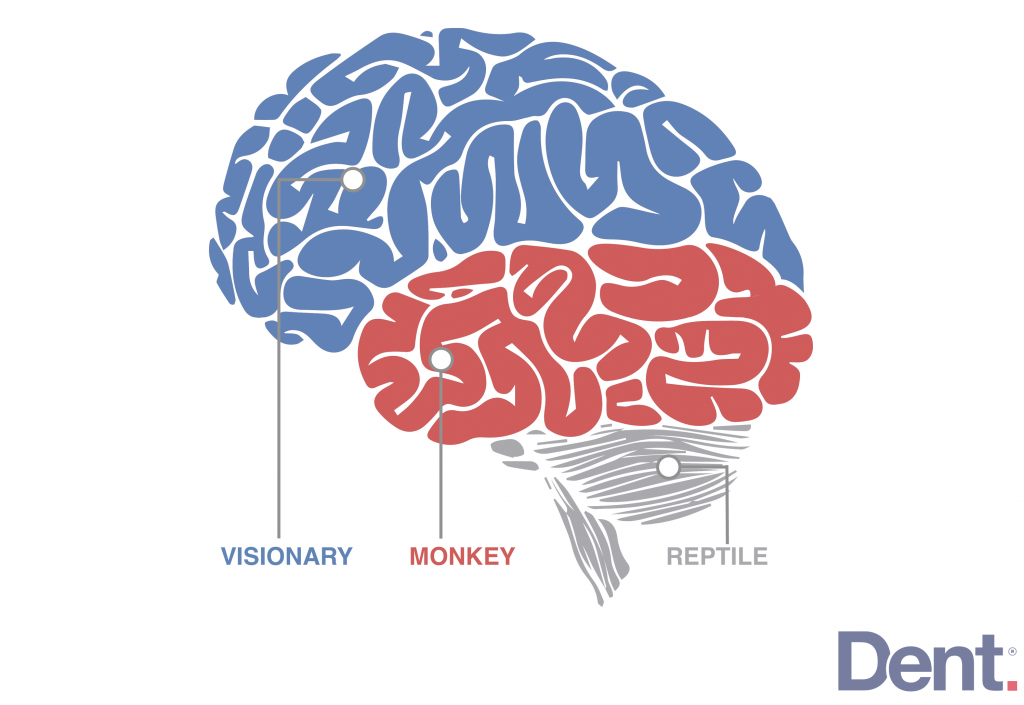Very superficially speaking, your brain is made up of three major structures:
1. The reptile – fight, flight freeze, fornicate (highly emotional in a bad way – aggression, fear, panic, etc).
2. The monkey – learn, remember, repeat, be safe (practical but not very emotional).
3. The visionary – get inspired, strategise, transform (emotional in a good way – passion, love, humour, etc).
In any given situation, these three parts of the brain are asking three very different questions:
1. The reptile asks “Is something threatening my survival?”
2. The monkey asks “Am I trained to deal with this situation?”
3. The visionary asks “What’s possible, where’s the opportunity, how could I influence this for the better?”
When you work in a large corporation the answers to these questions look like this:
1. Reptile – No your survival is not threatened. You could be a complete numpty and they’ll still pay you for 3-6 more months while they figure out what to do with you.
2. Monkey – Yes. I’ve done this exact same day many times in the last hundred days.
3. Visionary – Not much. You’re not the CEO and even if you were, changing the brand of coffee we drink might take months.
For this reason, in a corporate environment, you rarely experience the low-lows of panic, fear or rage. You also don’t get the elation that comes with being the source of a big transformation.

When you work in your own small business your brain answers the questions differently:
1. Reptile – Yes your survival is in danger. This business is only surviving because you are working your guts out and if you do stop working the business will surely fall apart. What’s more, if you don’t stop working, you will fall apart.
2. Monkey – No you are not trained for this. The core skills you’re trained for now make up less than 30% of your time and the other 70% is stuff you didn’t even know existed back at your old job. What’s more, the school system seems to have taught you the exact opposite of what you now need to know (eg: “delegating” tasks to smarter kids).
3. Visionary – Anything IS possible. It’s your business and the world is your oyster; that kid Mark Zuckerberg started with nothing and he’s got $50Billion now so maybe you could do it too – let’s watch a TED Talk!

For this reason, you can swing from rage to optimism, fear to delight, anger to passion and everything else in the emotional spectrum every month. This is normal hard-wiring of the brain.
The short-term solution is having an understanding of how these mechanisms work, identifying your triggers, having an awareness of which part of your brain is firing and then making sure you only act upon the stuff the visionary gives the OK to.
Longer term, you need a buffer of cash personally and in the business to prevent your survival brain going into overdrive, you’ll need to surround yourself with highly-skilled people who know how to competently respond to situations and you’ll need to have a peer-group of big “change the world” types to bounce your crazy ideas off.
I hope that helps.
NOTE – This three-part model of the brain is highly simplified and massively outdated in terms of our understanding of the human brain. There’s more modern, nuanced and researched understanding’s of how your brain works BUT I’ve found this oversimplified model helpful in understanding why I often see rapid highs and lows in entrepreneurs. When it comes to understanding other behaviors, I draw upon various other sources.
This article was originally published on LinkedIn.












